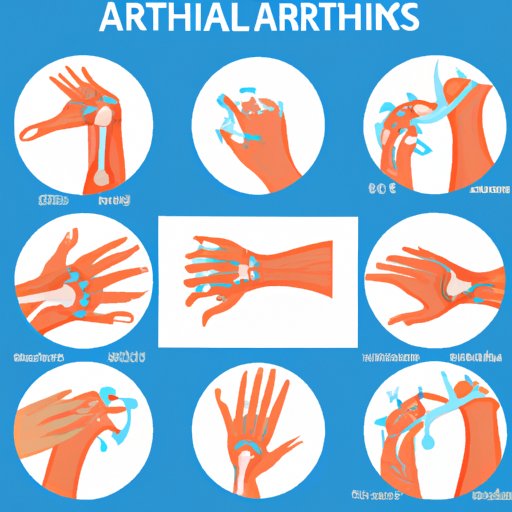How Do You Know If You Have Arthritis?
Arthritis is a common yet potentially debilitating condition that affects people of all ages. According to the Centers for Disease Control and Prevention (CDC), more than 54 million adults in the United States have been diagnosed with some form of arthritis. The condition causes joint pain, stiffness, and inflammation, which can interfere with daily activities and decrease quality of life. Therefore, it’s important to recognize the symptoms of arthritis early on and take action. In this article, we’ll cover the most common symptoms of arthritis, the diagnosis process, the different types of arthritis, the lifestyle risks, and treatment options. We’ll also offer tips for coping with arthritis and managing its symptoms.
Symptom Checklist
The symptoms of arthritis can vary depending on the type of arthritis. However, some of the most common symptoms include:
- Joint pain, swelling, or stiffness
- Decreased range of motion
- Fatigue
- Fever
- Weight loss
- Redness, heat, or warmth in the affected joint
If you’re experiencing any of these symptoms, it’s important to check with your doctor.
Diagnosis Process
When you visit your doctor for arthritis symptoms, they will likely perform several tests to diagnose the underlying cause. The diagnosis process may include:
- Physical exam: your doctor will examine your joints for tenderness, swelling, or range of motion.
- Blood tests: to check for signs of inflammation or infection in the body.
- Imaging tests: such as X-rays, CT scans, ultrasounds, or MRI scans to get a detailed picture of your joints.
Based on the results of these tests, your doctor can determine the type and severity of arthritis you’re experiencing.
Types of Arthritis
There are more than 100 types of arthritis, but the most common types include:
- Osteoarthritis: the most common type of arthritis in which the cartilage that cushions the ends of bones gradually deteriorates, causing pain and stiffness.
- Rheumatoid arthritis: an autoimmune disease that causes joint pain and swelling, which can eventually lead to bone erosion and joint deformity.
- Gout: a type of inflammatory arthritis that causes sudden, severe pain, redness, and tenderness in the joints, often affecting the big toe.
- Juvenile arthritis: a condition that affects children and teenagers, causing joint pain, stiffness, and swelling.
- Ankylosing spondylitis: an inflammatory arthritis that mostly affects the spine, causing stiffness and pain in the neck and back.
Each type of arthritis presents with different symptoms, so it’s important to get a proper diagnosis to receive appropriate treatment.
Lifestyle Risks
While the exact causes of arthritis are unknown, some factors can increase your risk of developing the condition. These include:
- Age: as we age, the cartilage in our joints naturally wears down, making us more prone to arthritis.
- Gender: women are more likely to develop rheumatoid arthritis, while men are more likely to develop gout.
- Obesity: carrying excess weight puts extra pressure on the joints, increasing the risk of arthritis.
- Injury: joint injuries and traumas can increase the risk of developing arthritis later in life.
- Family history: if you have a family history of arthritis, you’re more likely to develop the condition.
While some of these factors are out of our control, we can reduce our risk of developing arthritis by making lifestyle changes. For instance, maintaining a healthy weight, avoiding injuries to the joints, and minimizing stress on the joints through low-impact exercises such as swimming or cycling.
Treatment Options
Treatment for arthritis typically depends on the type and severity of the condition and may include:
- Medications: such as pain relievers, anti-inflammatories, and disease-modifying antirheumatic drugs (DMARDs).
- Therapy: such as physical therapy, occupational therapy, or counseling to help manage the emotional impact of the condition
- Surgery: in some cases, joint replacement or joint fusion may be necessary when other treatments aren’t effective.
Your doctor may also recommend complementary or alternative therapies, such as acupuncture, massage, or herbal supplements. Before trying any new therapy or supplement, make sure to talk to your doctor to ensure it’s safe and effective.
Coping with Arthritis
Living with arthritis can be challenging, but there are several ways to manage the symptoms and improve daily quality of life:
- Exercise regularly: low impact exercises such as swimming or cycling can help reduce joint pain and stiffness.
- Eat a balanced diet: maintaining a healthy diet rich in fruits, vegetables, and lean protein can help reduce inflammation in the body.
- Get enough sleep: getting enough rest can help reduce fatigue and joint pain.
- Reduce stress: practicing relaxation techniques, such as meditation or deep breathing, can help manage stress and anxiety associated with arthritis.
- Work with your doctor: following your treatment plan and communicating regularly with your doctor can help manage symptoms and potentially slow the progression of the condition.
Conclusion
In conclusion, arthritis can significantly impact quality of life, particularly if left undiagnosed or untreated. By recognizing the symptoms of arthritis early on and seeking medical attention, you can receive the appropriate treatment and gain control over the condition. Additionally, lifestyle changes such as exercise, a healthy diet, and stress reduction techniques can help reduce symptoms and improve daily quality of life. If you’re experiencing joint pain or stiffness, don’t hesitate to consult your doctor to receive a proper diagnosis and begin treatment.
